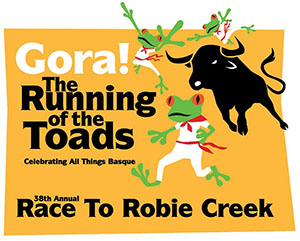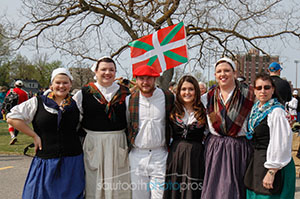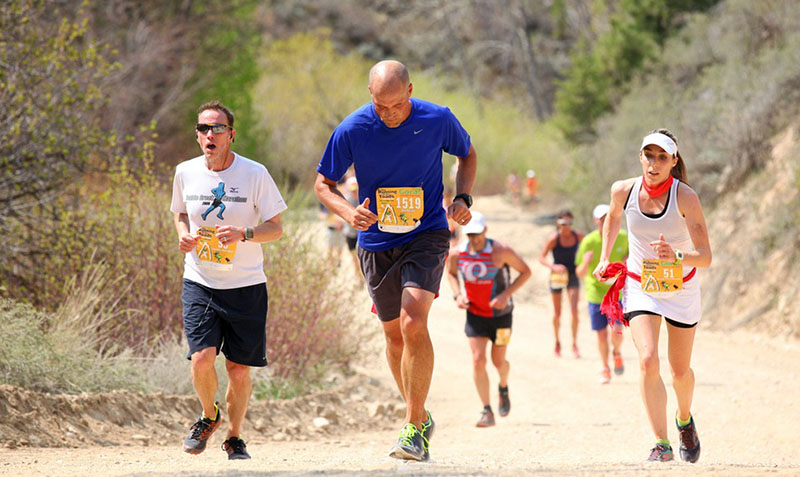Boise, ID. There were sporty men and women running, some galloping, and some others just walking, enjoying the day. 2,400 registered participants in total. But there were also around 800 volunteers helping the organization to make it all happen. Amongst them, many Basques.
 Basque Boiseans have always been involved with this race –which is also known as the long climb to Aldape Summit, named after Basque-American Felipe Aldape − but this year was a special one, since the main theme was also Basque, the slogan being “Gora! The Running of the Toads,” in reference to the running of the bulls of Pamplona. “There’s a different theme every year –said Rencher− and since Boise has a strong and rich Basque heritage, we voted for it. But the Basque community has always helped us a lot, not just this year”.
Basque Boiseans have always been involved with this race –which is also known as the long climb to Aldape Summit, named after Basque-American Felipe Aldape − but this year was a special one, since the main theme was also Basque, the slogan being “Gora! The Running of the Toads,” in reference to the running of the bulls of Pamplona. “There’s a different theme every year –said Rencher− and since Boise has a strong and rich Basque heritage, we voted for it. But the Basque community has always helped us a lot, not just this year”.
Dan Ansotegui and Jill Aldape, from the music Boisean Basque band Amuma Says No, were a great help to the group that put it together, explaining the culture and history. But the Oinkari dancers and many of the Basque businesses of the city did their part too.
“I was at the beginning of the race and played txalaparta with my sister Alaina and Lael (Uberuaga),” explained Annie Gavica, education program specialists of the Basque Museum and Cultural Center. “Oinkaris performed a part of Ikurrina dantza and Mayor Bieter started the race by yelling ‘Gora, Gora Gora!’, as well as another dancer doing an irrintzi.” “It was pretty cool,” she added.
In her opinion, “everyone had a great time celebrating Basque culture and the running culture in Boise. It was a nice overlap.” Some runners were seen in San Fermin costumes, as reported by Rencher, and some others even wearing like frogs, since those animals have a history with Robie Creek.
In June, after having payed all the bills, the organization will donate all the profits to charity. Last year the race donated $81,550 and they expect to have raised a similar amount of funds.
Robie Creek and the toads…
 As explained by Gavica, “the toads have a history with Robie Creek from the very beginning that still holds true today. The route is a gravel and dirt road to Robie and people drive it all the time. Apparently, there are quite a few toads in the area that get squished by the drivers and end up flat on the road. From what I heard, the runners would see them and some would pick them up and throw them. They earned the name ‘sailtoads’ because, after being there for a while, they are rather flat and dry like a Frisbee.”
As explained by Gavica, “the toads have a history with Robie Creek from the very beginning that still holds true today. The route is a gravel and dirt road to Robie and people drive it all the time. Apparently, there are quite a few toads in the area that get squished by the drivers and end up flat on the road. From what I heard, the runners would see them and some would pick them up and throw them. They earned the name ‘sailtoads’ because, after being there for a while, they are rather flat and dry like a Frisbee.”
…and the Basques
The organization, as part of the promotion, wrote a short fictional story explaining the connection between Robie Creek, the toads, and the Basques:
The Legend of Robie Creek − The Basque Chapter
First came Red Man. Red Man was at peace with the land. The mountain rose and the water sparkled. There was peace.
White Man came. He cut a giant slash on the land and over the mountain. He paraded his stagecoaches and later his automobiles over the slash. The slash destroyed the Red Man’s trail. The dust kept the waters from sparkling. The game departed. There was no peace.
Greenthing lived in the waters. He wanted to bring peace to Red Man and White Man. He wanted peace for the land. He attempted to stop the parading but he was smashed flat and sailed over the land. It was said that at times the paraders swerved to flatten Greenthing. Still, there was no peace.
Decades passed. A highway was built to bypass the sacred mountain. All was quiet. And then….Basque Man came.
He loved the land and honored the mountain. He brought his sheep and cattle and his culture to this land. Often he would dance beside the campfire and dream of his homeland. He piled rocks to make Stone Boys to give thanks and express his joy.
One day, the artzaina (sheepherder) was taking his ardikanpoa (wagon) to the summit. He happened on Greenthing. Far from swerving to hurt him, he jumped down, picked him up, and placed him on the seat. “Aupa Txantxikua” (chan – chee – koo – ah, meaning toad as well as inhabitant of the town of Basque town of Oñati, Gipuzkoa), “There you are, little toad. I am happy to see you. I am from Oñati in the old country. We address all people from our village with these words. Basques celebrate all things Basque. Come with me to the summit and we will celebrate.”
The proud Basque stood on the summit looking on the city below. Many Basques lived in peace and prosperity there. “Txantxikua, please help me protect and celebrate this land. I will name this summit for my family in the home land and my family in the new world.
“I will name this summit Aldape. And on the designated day, the Running of the Toads will celebrate all that is Basque! Gora! Gora!”
Txantxikua smiled. Red Man, White Man, Basque Man…. all that is old, all that is new… finally, on this magic mountain, there was peace.






 Basque Boiseans have always been involved with
Basque Boiseans have always been involved with  As explained by Gavica, “the toads have a history with Robie Creek from the very beginning that still holds true today. The route is a gravel and dirt road to Robie and people drive it all the time. Apparently, there are quite a few toads in the area that get squished by the drivers and end up flat on the road. From what I heard, the runners would see them and some would pick them up and throw them. They earned the name ‘sailtoads’ because, after being there for a while, they are rather flat and dry like a Frisbee.”
As explained by Gavica, “the toads have a history with Robie Creek from the very beginning that still holds true today. The route is a gravel and dirt road to Robie and people drive it all the time. Apparently, there are quite a few toads in the area that get squished by the drivers and end up flat on the road. From what I heard, the runners would see them and some would pick them up and throw them. They earned the name ‘sailtoads’ because, after being there for a while, they are rather flat and dry like a Frisbee.” Send to a friend
Send to a friend Add comment
Add comment








